The egg shell and mineral metabolism
The egg shell: a case study in improving quality by altering mineral metabolism – naturally
Our research has focused on finding ways to reduce the proportion of cracked eggs, primarily by increasing egg shell strength. The egg shell is de facto a porous structure with approximately 7 to 17 thousand pores. The density of these pores is greater on the pointed end of the egg. The number and size of these pores can have a negative effect on egg quality, e.g., lower hatchability. In addition, the egg shell represents the first line of defense against microbial contamination of egg white.
The number of cracked eggs is influenced by many factors; and it is important to remember that the occurrence of cracked eggs is due to more than one reason. Such factors involve nutritional status, health condition of the flock, microclimate, management, housing and egg handling. In spite of our extensive knowledge about the factors contributing to the incidence of cracked eggs, it remains impossible to eliminate all problems associated with egg shell quality. The following paper reports work from our group on the effects of altering trace mineral form on aspects of egg shell quality and the consequent effects on egg production and fertility.
The egg shell
STRUCTURE AND COMPOSITION
The egg shell is comprised of five layers: an inner egg shell membrane, an outer egg shell membrane, the mammillary layer, spongy layer and cuticle. The egg shell membranes are also called the 'organic matrix'; and their importance and effect on egg shell quality are often neglected. This matrix is comprised of a combination of proteins and mucopolysaccharides. Most of the protein is made up of keratin with a high concentration of sulfur (70- 75%) while about 10% of the protein is collagen. The amino acid ratio of matrix proteins changes as the hen ages and these changes are reflected in the quality of egg shell.
Changes in synthesis and secretion of egg shell membranes may have negative effects on shell formation and ultimately on quality. Adequate amounts of certain trace minerals, particularly manganese and zinc, are very important for the synthesis of these membranes, which form the basis of the calcified part of egg shell. Deficiencies in either mineral have negative effects on formation of membranes, egg shell morphology and egg production. These problems result very probably from the role that manganese plays in the process of synthesis of mucopolysaccharides. It seems that this glucoprotein structure influences calcification of egg shell. Moreover, zinc is indispensable for proper formation of keratin.
The mammillary layer is formed by cells of irregular conical shape forming irregular conical structures on the outer egg shell membrane. They form approximately one third of egg shell thickness. The so-called spongy layer is very firm; and its firmness increases in the direction of the egg shell surface. This layer forms approximately two thirds of egg shell thickness.
The cuticle is an organic layer on the egg shell surface that prevents penetration of microorganisms into the egg. It contains a high proportion of surface pigments.
From the chemical point of view, the egg shell consists of water (2%) and dry matter (98%). The dry matter is composed of 5% crude protein and 93% ash. Average values of mineral contents in different parts of the egg and egg shell, as found in our experiments, are presented in Table 1.
FACTORS AFFECTING EGG SHELL QUALITY
Obtaining an egg with a smooth and strong egg shell is desirable. Shells from eggs collected immediately after lay as well as those of big eggs are more susceptible to cracking. The hen is able to deposit only a certain amount of calcium into the egg shell and this amount is influenced by genotype. This means that increasing the level of calcium in the diet will not necessarily improve the quality of egg shell (Ceylan and Scheideler, 1999). As hens age, egg size increases such that a constant amount of calcium is distributed over a larger surface. This means that changes in egg weight and the age of layers influence the quality of egg shell. Changes in temperature inside the laying house influence feed intake and therefore egg size. The fact that the egg shell is thick does not necessarily mean that it is also strong. Sometimes a thin egg shell may be stronger than a thick shell.
Table 1. Egg composition as analyzed in our experiments.
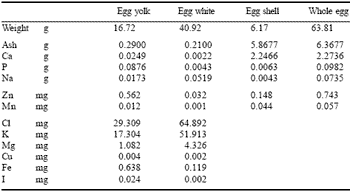
Calcium and the egg shell
It is obvious that in order to maintain good egg shell quality it is necessary to assure adequate nutrition. Hens producing approximately 300 eggs per year must deposit 24 times more calcium into egg shells than the amount contained in their bones. For that reason, the requirements for calcium supply in the diet are enormous. During the 20 hr period in which the egg shell is formed, the hen must deposit 25 mg of calcium on the egg surface every 15 minutes.
As the hen can only obtain 30-50% of total dietary calcium (depending on its source, size of particles, health condition of birds, etc.), the amount of dietary calcium that must be supplied daily ranges from 3.2 to 4.5 g (depending on production level, daily feed intake, environmental temperature and other factors).
Availability of calcium from various sources differs. Ground shells of marine animals are the best source of calcium followed by egg shells. These organic sources are followed by aragonite and then by common limestone. The most sensitive response to calcium deficiency can be observed in hens at the age of 150-180 days. Toward the end of the laying period, the utilization of calcium generally decreases. This can be partly improved by a change of calcium source.
Important also is the particle size in which calcium is supplied to hens. The coarser the particles, the longer the residence time in the upper gastrointestinal tract. The release of calcium from coarser particles is slower; and this fact may be important given that shell formation is continuous and proceeds during the non-daylight hours when layers do not eat. This is demonstrated by the fact that shells of eggs laid in the afternoon are usually thicker. The presence of adequate amounts of vitamin D3 in relation to calcium is obviously also important. However, increased doses of this vitamin do not affect the quality of egg shell.
Zinc and the egg shell
Along with calcium, carbonate ions are needed in formation of calcium carbonate. However, they are usually neglected as a potential cause of problems associated with egg shell quality. Carbon dioxide, which is present in the oviduct as a common product of cell metabolism or as a gaseous compound in blood, is the main source of carbonate ions. The carbonic anhydrase enzyme requires the presence of zinc and catalyses formation of carbonic acid from water and carbon dioxide. In non-laying hens, activity of carbonic anhydrase is lower than in laying hens. Ceylan and Scheideler (1999) demonstrated that organic zinc was associated with higher activity of carbonic anhydrase and in turn with improved shell quality. The fact that zinc is a co-factor of this enzyme makes both activity and proper function of this enzyme potentially sensitive to trace elements, their interactions and availability. The dietary concentration of zinc needed to meet daily zinc requirements ranges from 40 to 60 mg/kg of feed dry matter. Zinc oxide and zinc sulfate have been the most commonly-used sources of zinc.
Manganese and the egg shell
The presence of manganese (Mn) has an activating effect on alkaline phosphatase; explaining the importance of this element in proper formation of bone tissue and egg shell. Ochrimenko et al. (1992) noted a positive effect of manganese supplements on calcification and egg shell strength. In experiments carried out by Sazzad et al. (1994), no effects of increased amounts of manganese in the diet on production and weight of eggs were observed. However, egg shell thickness increased significantly. These authors recommended that laying hens receive 105 mg/kg Mn in the diet. Manganese deficiency decreases egg shell weight; which may support the hypothesis regarding the importance of manganese as a enzyme co-factor in controlling synthesis of mucopolysaccharides.
Phosphorus and the egg shell
A surplus of phosphorus in the diet has a negative effect on egg shell quality. For that reason it is important to maintain an optimum ratio of phosphorus and calcium, which widens as the hen ages. If calcium is supplied in powder form, the optimum phosphorus/calcium ratios from week 19 to 50 and after week 50 of age are 1:9-10 and 1:11-12, respectively. However, if calcium is supplied in the form of coarse particles (65%, 2-4 mm), the optimum phosphorus/calcium ratios are 1:10-11 and 1:12-13 for weeks 19-50 and after week 50 of age, respectively. The phosphorus requirement of hens increases in a hot environment.
Magnesium and the egg shell
Magnesium deficiency reduces egg production, calcium deposition and formation of egg shell. In practice, however, it is not necessary to supplement diets with special amounts of magnesium because its content in vegetablebased feed ingredients and common (dolomitic) sources of limestone is sufficient.
Research at Mendel University: applications for organic sources of trace elements in poultry nutrition
Mineral proteinates are obtained by means of hydrolysis of a protein source such that the resulting hydrolysate contains a mixture of amino acids and small peptides with chains of different lengths. This hydrolysate is then reacted with metal salts to form complexes containing chelated metallic ions (Hynes and Kelly, 1995). In this way stable chelates are formed which protect trace elements against chemical reactions taking place in the course of digestion. This protection maintains the solubility of these substances during their passage through the gastrointestinal tract to the sites of absorption. In the small intestine, chelates are thought to be absorbed via peptide and amino acid routes as opposed to the passive absorption mechanisms of ions derived from inorganic mineral sources (Close, 1998).
Such absorption would explain the apparent decrease in interaction between mineral forms shown in various reports as well as allowing inorganic and organic forms to be used together to advantage. Greater stability during digestion, along with absorption and transport via peptide and amino acid routes, results in higher biological availability.
Differences in the bioavailability of various trace mineral sources for layers have been demonstrated in numerous studies in cattle and pigs, however there are fewer experiments with organic mineral forms in poultry. In the case of manganese, the two sources primarily used for supplementation of animal diets are manganous oxide and manganous sulfate. Using manganous sulfate as a basis for comparison, (i.e. 100 %), the relative biological availabilities of manganous oxide, manganese dioxide and manganese carbonate are 60-80%, 30-40% and 25-40%, respectively (McDowell, 1992).
However, it was found that the availability of organic forms of this element was higher than that of manganous sulfate (Henry, 1995). Gomez-Basauri (1997) summarized the responses to mineral proteinates in layers both in research and commercial trials.
The topic of organic trace elements in diets for laying hens has been studied at the Mendel University of Agriculture and Forestry in Brno (Czech Republic) over the past five years (Klecker and Zeman, 1996; Klecker et al., 1996; 1997a; 1997b; Svobodova-Cizkova, 1998; Bunesova, 2000). The following presents a summary of the experiments done in this period and details new results in applications of organic forms of trace minerals in laying hens and cockerels.
MATERIAL AND METHODS: EXPERIMENTS 1-5
Experiments 1, 2 and 3 were carried out in cages in the experimental poultry house at Mendel University of Agriculture and Forestry (MUAF) in Brno using 640 laying hens (hybrid ISA Brown obtained from Integra Zabcice, Czech Republic). Experiment 4 was done in large-scale commercial conditions using 12,000 parent stock ISA Brown birds. Experiment 5 was carried out on ISA Brown cockerels also in the experimental poultry house at MUAF. For all experiments, diets were formulated and fed according to age. Basal diets were formulated as per NRC (1994) and Zelenka et al., 1999. Formulations, nutrient and mineral contents are listed in Table 2. Egg production, egg weight and feed consumption were measured daily. At four week intervals two eggs from each hen were analysed for the following parameters: egg shell weight, egg shell thickness, egg shell strength, standard egg yolk and egg white measurements. Strength of the egg shell was measured by the destruction method with the use of an egg crusher (Veit Electronics CZ). In Experiment 2 egg shell quality was observed by scanning electron microscope using methods described by Jelinek and Lhotecky (1996).
Experiment 1: Effects of substituting 20 or 40% of the inorganic zinc and manganese with Bioplex proteinates
The basal diet contained inorganic forms of zinc and manganese. In the treatment diets either 20 or 40% of the inorganic zinc and manganese was replaced by organic forms (Bioplex Zinc and Bioplex Manganese) from week 17 to week 67 of age.
Experiment 2: Effects of replacing 50% of the inorganic zinc and manganese with Bioplex proteinates
The basal diet contained inorganic forms of zinc and manganese. The treatment diets consisted of replacing 50% of the inorganic zinc and manganese either together or separately by organic forms (Bioplex Zinc and Bioplex Manganese). This experiment lasted from week 17 to week 72 of age.
Table 2. Feed mixture formulation, nutrient and mineral contents of feed mixtures for layers.
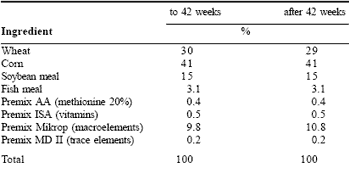
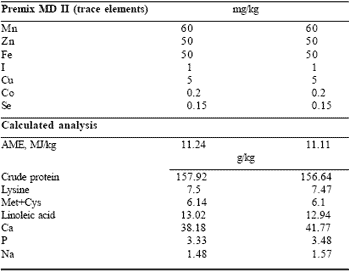
Experiment 3: Effects of Eggshell 49 added to the basal diet under controlled conditions
The control group received the basal diet and the experimental group received the same diet with the addition of Eggshell 49 (Alltech Inc.) in the amount of 2 kg/tonne of feed. The experiment lasted from week 53 to week 72 of age.
Experiment 4: Effects of Eggshell 49 on performance of parent stock under commercial conditions
The experiment was conducted on a commercial farm with 12,000 parent stock birds. In this experiment, the effect of Eggshell 49 supplementation on the percentage of selected hatching eggs was observed. The experiment was conducted on receiving a request from the poultry breeder who complained that his selection of hatching eggs was too low. Experiment 5: Effect of organic zinc, manganese and selenium fed to cockerels on fertilization of hatching eggs In this experiment, which lasted from week 25 to week 40, ISA Brown cockerels were divided into two groups. The control group was given a diet containing the mineral premix MD II (Table 2), which contained only inorganic forms of trace minerals. In the experimental group 50% of the zinc, manganese and selenium was substituted with proteinates (Bioplex Zinc, Bioplex Manganese) and by organic selenium (Sel-Plex). The objective of this experiment was to determine whether the organic mineral substitution would effect fertilization of hatching eggs.
RESULTS
Experiment 1: Effects of substituting 20 or 40% of the inorganic zinc and manganese with Bioplex proteinates
Bioplex Zinc and Bioplex Manganese significantly increased egg shell strength (Table 3, Figure 1). Detailed statistical analysis demonstrated a significant improvement of egg shell strength as early as week 24, i.e. 28 days after the onset of lay. A positive improvement was also observed in egg mass and in daily egg production (Table 3, Figure 3). In all cases, both daily egg production and production of egg mass were higher than model data presented by the ISA company for hybrid ISA Brown hens (ISA Brown, 1993a; 1993b). Means were not significant owing to the relatively small number of hens in the study.
Table 3. The effect of substituting 20 or 40% of the inorganic zinc and manganese with Bioplexes on performance and egg shell parameters (Experiment 1).

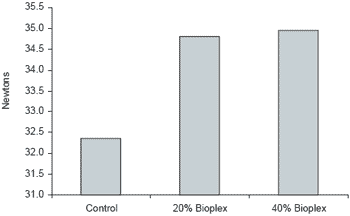
Figure 1. Effects of substituting 20 or 40% of the inorganic zinc and manganese with Bioplexes on egg shell strength (Newtons) (Experiment 1).
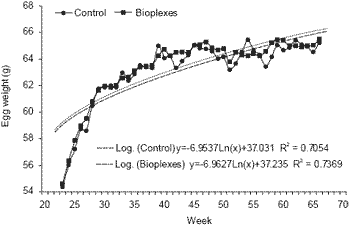
Figure 2. Effects of substituting 20 or 40% of the inorganic zinc and manganese with Bioplexes on egg weight (g) (Experiment 1).
The relationships between hen age and weekly egg production and egg mass were determined using biometric analysis. For evaluation, analysis of variance and orthogonal polynomials were used and results compared with the ideal laying curve for model production determined by the breeder company (ISA Brown, 1993). This comparison revealed a number of significant differences in response to Bioplex substitution. Equations and correlation coefficients are presented in Figures 2, 3 and 4. These equations indicated that supplementing the laying diet with Bioplexes slightly improved egg weight, daily production of egg mass and feed consumption per egg mass produced. In Figure 3 it can be seen that hens given Bioplexes had higher egg mass production. Reviewing the variation in weekly values, it was found that hens fed Bioplexes had a more uniform course of egg production. From the correlation coefficient (R2) it can be seen that where Bioplexes were administered 73% of values lie on the theoretically calculated curve. On the other hand, in the control group only 13% of measured values lie on the theoretically calculated curve. In addition, higher uniformity was demonstrated for egg weight, feed consumption per egg mass produced and egg shell strength in the group given the organic minerals (Figures 2, 4 and 5).
Figure 6 demonstrates that for all main parameters (daily egg production, egg mass production, egg weight, egg shell strength) correlation coefficients were higher in the groups given Bioplexes compared to the groups with inorganic minerals, indicating higher uniformity. A similar trend was noted in Experiment 2 (Figure 6).
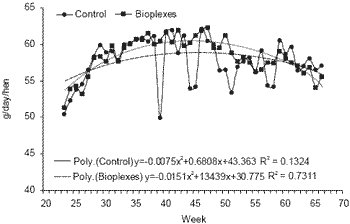
Figure 3. Effects of substituting 20 or 40% of the inorganic zinc and manganese with Bioplexes on egg mass produced (g/day/hen) (Experiment 1).

Figure 4. Effects of substituting 20 or 40% of the zinc and manganese by Bioplexes on feed consumption per egg mass produced (kg/kg) (Experiment 1).
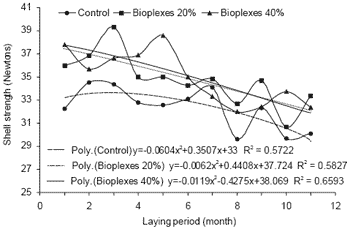
Figure 5. Effects of substituting 20 or 40% of the inorganic zinc and manganese by Bioplexes on egg shell strength (Newtons) (Experiment 1).

Figure 6. Correlation coefficients for performance and egg shell parameters (Experiments 1 and 2).
Experiment 2: Effects of replacing 50% of the inorganic zinc and manganese with Bioplex proteinates
Substitution of both zinc and manganese produced the best performance (Table 4), indicating an additive effect in this experimental design. Egg shell thickness was increased significantly in response to all experimental diets (Figure 7). In addition, all treatments reduced the percentage of cracked eggs. In all treatment groups (controls and experimental groups) laying performance and production of egg mass were higher than model values recommended by the ISA company for hybrid combination ISA Brown layers.
Results of a mathematical evaluation of the egg production curve, egg weight and egg mass production from week 23 to 72 of age are presented in Figures 8, 9 and 10. Equations and correlation coefficients are presented as a part of these graphs.
The most interesting response to 50% substitution with Bioplexes in this experiment occurred in egg weight (Figure 9). Using logarithmic transformation it was observed that the group given both organic zinc and manganese had higher egg weights. Uniformity was also improved as indicated by higher correlation coefficients.
Egg shells were examined by scanning electron microscopy (Jelinek and Lhotecky, 1996) and results are illustrated in Figure 11 (A-D). The upper two (Figures A and B) show differences of crystallization centers of the mammillary layer between experimental and control groups at 120X enlargement.
At present this is the subject of further research at MUAF. Photographs C and D show egg shell fracture at the same enlargement and demonstrate the thicker egg shell when hens were given the Bioplex-supplemented diets.
Table 4. The effect of substituting 50% of inorganic zinc and manganese with Bioplexes separately and in combination on performance and egg shell parameters (Experiment 2).
To enlarge the image, click here
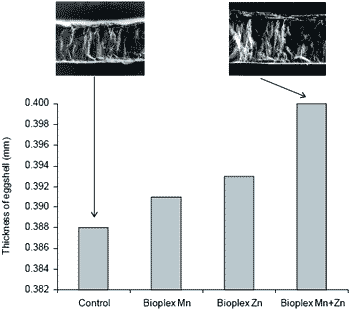
Figure 7. Effect of substituting 50% of the inorganic zinc and manganese with Bioplexes separately and in combination on thickness (mm) of egg shell (enlargement 120X) (Experiment 2).
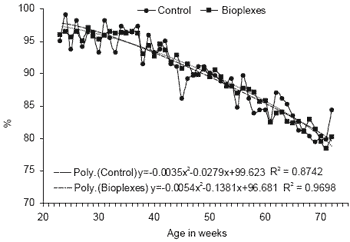
Figure 8. The effect of substituting 50% of the inorganic zinc and manganese with Bioplexes on egg production (%) (Experiment 2).

Figure 9. The effect of substituting 50% of the inorganic zinc and manganese with Bioplexes on egg weight (g) (Experiment 2).
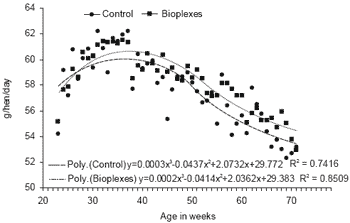
Figure 10. The effect of substituting 50% of the inorganic zinc and manganese with Bioplexes on egg mass production (g/hen/day) (Experiment 2).
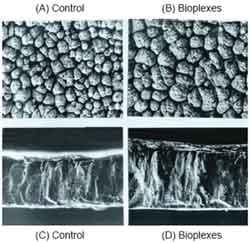
Figure 11. The effects of Bioplexes on mamillary layer cells in egg shell (A, B) and on thickness of egg shell (C,D) (Experiment 2).
Experiment 3: Effects of Eggshell 49 added to the basal diet under controlled conditions
Hens given Eggshell 49 had higher egg production (+2.47%) after 19 weeks (Table 5). Egg weight increased from 65.05 to 66.20 g, eggshell thickness was increased (P< 0.05) from 0.386 to 0.403 mm, shell weight increased from 5.990 to 6.270 g and egg shell strength increased from 28.05 to 29.76 Newtons.
Table 5. The effect of Eggshell 49 from week 53 to week 72 of age on performance of laying hens and egg parameters (Experiment 3).
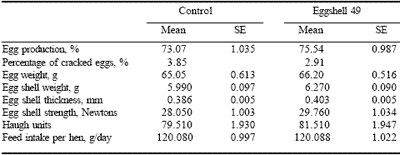
Quality of the egg white also improved in response to Eggshell 49 as indicated by the increase in Haugh units. The percentage of cracked eggs decreased from 3.85 to 2.91%.
Experiment 4: Effects of Eggshell 49 on performance of parent stock birds under commercial conditions
On this poultry farm, the percentage of selection of hatching eggs was initially low (71.5%). After three weeks, Eggshell 49 supplementation was interrupted for a period of four weeks and thereafter the application was resumed for another four weeks. Results are presented in Figure 12. Eggshell 49 increased the selection of hatching eggs by 4-5%, an effect that lasted for the 3-week supplementation period. When supplementation was interrupted, hatching egg percentage decline to previous values. Performance again increased during the second period of supplementation after week 54 of age and this positive effect persisted till the end of this experiment.
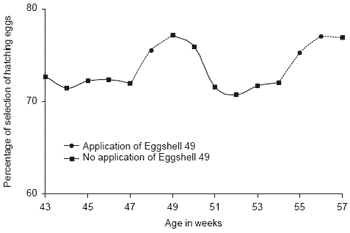
Figure 12. The effect of Eggshell 49 in layer diets during two periods on selections of hatching eggs (Experiment 4).
Experiment 5: Effect of organic zinc, manganese and selenium fed to cockerels on fertilization of hatching eggs
Substitution of 50% of the inorganic manganese, zinc and selenium with Bioplex Zinc, Bioplex Manganese and Sel-Plex in diets for cockerels increased fertilization of hatching eggs (Figure 13). At the first collection of eggs at week 27, an increase of 4.85% in fertilization of hatching eggs was noted while at the second collection at week 38, there was in increase of 3.76% for the group given Bioplexes and Sel-Plex. This increase could be explained in part through effects on spermatogenesis.

Figure 13. The effect of substituting 50% of the inorganic zinc, manganese and selenium with Bioplexes and Sel-Plex addition in diets fed cockerels on fertilization of hatching eggs (Experiment 5).
Conclusions
Based on these data, the organic sources were of greater value in providing nutrients limiting in egg production and fertility. Substitution with proteinates had a beneficial effect on egg shell quality and total egg production which translated to a larger percentage of hatching eggs, hatchability and consequently to improved economics for the egg producer. In summary, use of mineral proteinates (Bioplex Zinc and Bioplex Manganese) and Eggshell 49 in diets for poultry in our experiments resulted in:
- A significant increase in egg shell strength. This response was observed as early as six weeks after beginning supplementation (after week 23 of age) and persisted for the whole period of administration.
- Improved laying performance, egg weight and egg mass.
- Significant improvement in uniformity of the laying curve, egg weight and egg mass production. Higher uniformity is very favourable for egg producers because it indicates more eggs that can be sold in the higher quality grades.
- Alterations in the crystallization centers of the mammillary layer and increased percentage of hatching eggs. The increase in percentage of hatching eggs was observed as early as one week after beginning supplementation.
- In cockerels with reduced fertility, the application of Bioplex Zinc, Bioplex Manganese and Sel-Plex increased fertilization of hatching eggs.
References
Authors: VLADIMIR SISKE1, LADISLAV ZEMAN2 and DALIBOR KLECKER2Bunesova, A. 2000. Analysis of performance of laying hens in dependence on application of various form of minerals. Ph.D. disertation, Mendel University of Agriculture and Forestry, Brno, Czech Republic, p. 103.
Close, W.H. 1998. New developments in the use of trace mineral proteinates to improve pig performance and reduce environmental impact. In: European Lecture Tour, Alltech Inc. Technical Publications, Nicholasville, KY, USA, p. 51-68.
Ceylan, N. and S.E. Scheideler. 1999. Effects of Eggshell 49, dietary calcium level and hen age on performance and egg shell quality. In: Biotechnology in the Feed Industry, Proceedings of the 15th Annual Symposium (T.P. Lyons and K.A. Jacques, eds), Nottingham University Press, Nottingham, UK. p. 61-73.
Gomez-Basauri, J. 1997. Eggshell quality and economic losses: The potential for improvement with dietary trace mineral proteinates. In: Biotechnology in the Feed Industry, Proceedings of the 13th Annual Symposium (T.P. Lyons and K.A. Jacques, eds), Nottingham University Press, Nottingham, UK., p. 381-388.
Henry, P.R. 1995. Manganese bioavailability. In: Bioavailability of Nutrients for Animals. (C.B. Ammerman, D.H. Baker and A.J Lewis, eds). Academic Press, San Diego-New York-Boston-London-Sydney-Tokyo- Toronto. p. 239-256.
Hynes, M.J. and M.P. Kelly. 1995. Metal ions, chelates and proteinates. In: Biotechnology in the Feed Industry, Proceedings of the 11th Annual Symposium (T.P. Lyons and K.A. Jacques, eds), Nottingham University Press, Nottingham, UK. p. 233-248.
ISA Brown. 1993a. Management Guide, Commercial Layers. ISA, Lyon, France. p. 24.
ISA Brown. 1993b. Annex Management Guide, Commercial Layers. ISA, Lyon, France. p. 12.
Jelinek, K. And J. Lhotecky. 1996. Changes in egg shell ultrastructure in hens' cracked eggs. Zivocisna vyroba. 41(9):413-421.
Klecker, D. and L. Zeman. 1996. Organic trace minerals in Eggshell 49 improve egg shell quality. Poster presented at the 12th Annual Symposium Biotechnology in the Feed Industry, April 22-24th, Lexington, Kentucky.
Klecker, D., L. Zeman and A. Bunesova. 1996. Effect of Mn and Zn chelates on production of eggs. 47th Annual Meeting of the European Association for Animal Production. Lillehammer, Norway. 25-29, p. 91.
Klecker, D., L. Zeman and A. Bunesova. 1997a. Effect of organic selenium on the qualitative parameters of eggs. 48th Annual Meeting of the European Association for Animal Production. Wien. 25-28, p. 295.
Klecker, D., L. Zeman, V. Siske, J. Gomez Basauri. 1997b. Influence of trace mineral proteinate supplementation on egg shell quality. Poultry Sci. 76(Suppl. 1)131.
McDowell, L.R. 1992. Minerals in Animal and Human Nutrition. Academic Press. San Diego.
NRC. 1994. Nutrient Requirements of Poultry, Ninth Revised Edition, National Academy Press, Washington, D.C., p. 19-34.
Ochrimenko, C., A. Lemser, G. Richter, U. Krause and H. Bonsak. 1992. Effect of the manganese content in laying hen feed with different Ca and mineral levels on the egg shell quality and bone mineralization of hens. Arch Tierernahr, 42(1):25-45.
Sazzad, H.M., A.G. Bertechini, P.T.C. Nobre. 1994. Egg production, tissue deposition and mineral metabolism in two strains of commercial layers with various level of manganese in diet. Anim. Feed Sci. and Tech. 46:3- 4, pp. 271-275.
Svobodova-Cizkova, J. 1998. Effects of manganese, zinc and chromium chelates on blood parameters, egg shell quality and mineral profile of bones in young and laying hens. Ph.D. dissertation, Mendel University of Agriculture and Forestry in Brno, Czech Republic, p. 122.
Wedekind, K.J., A.J. Lewis, M.A. Giesemann and P.S. Miller. 1994. Bioavailability of zinc from inorganic and organic sources for pigs fed corn-soybean meal diets. J. Anim. Sci. 72(2681-2689).
Zelenka, J., J. Heger and L. Zeman. 1999. Nutrient Requirements and Nutritional Value of Feed for Poultry, Czech Academy of Agricultural Science, Mendel University of Agriculture and Forestry, Brno, p. 63.
1 Alltech Czech Republic
2 Mendel University of Agriculture and Forestry, Brno, Czech Republic









.jpg&w=3840&q=75)